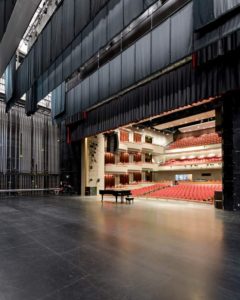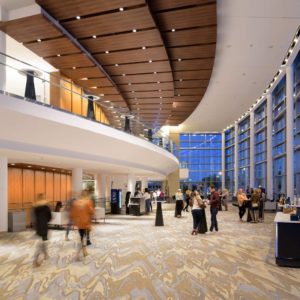The Sooner the Better or When to Hire a Theatre Consultant
Occasionally a theatre consultant will receive a call to help with a project that is already midway through design. The architect is looking for someone to specify performance equipment and develop the bid documents. The sad truth is by then it’s often too late for the architect, design team, and ultimately the client, to fully benefit from the expertise of a theatre consultant. It doesn’t have to be that way.

View of the house through the proscenium. The theatre consultant is involved in not only backstage but the arrangement of the audience chamber as well. Photo courtesy of Theatre Consultants Collaborative / by Rolen Image.
Many architects know going into a performing arts project of any type or size that they will need a theatre consultant. However, not all architects understand what they are getting into when they take on a performing arts space. There are few successful performance buildings designed without a theatre consultant on the team from the first sketch to first time the curtain rises.
One might think theatre consultants spend their time dreaming of cool LED moving lights, powerful lighting consoles, orchestra pit lifts, and heavy-duty rigging systems. Sure, theatre consultants are experts in specifying these kinds of systems. One might also understand that theatre consultants are heavily involved in the design of the audience seating and sightlines. In a well-designed performance facility, these topics represent just a small part of the typical theatre consultant’s scope of services.
Theatre consultants routinely provide expertise starting when a performing arts building is a glimmer in someone’s eye. It all begins with the fundamental questions. Who are the stakeholders and how will the building be used? What kind of stage and audience relationship is needed? What is the desired seat count? Where is the scenery built? How many dressing rooms are needed? These are just a few of the questions that need answers. A theatre consultant, preferably armed with information from a detailed design brief, can help an owner and architect sort out early critical decisions (See Where’s the Brief – Fall 2021.) Theatre consultants don’t always have the answers – but they know the questions to ask. They can do this because of deep experience in this building type.

The lobby of a performing arts center. The theatre consultant provides guidance in the public areas. Photo courtesy of Theatre Consultants Collaborative / by Rolen Image.
A theatre consultant lays early groundwork for the shape of the building during conceptual stages. Space programs, listing all the needed spaces and room sizes, are developed with input from owners and users help to define the overall size and arrangement of the building. Discussions of options for audience-performer relationships help determine what type of assembly space is best for the facility. How many performance venues are needed? No one is talking about the number of lighting circuits or the color of seats yet. It’s about the building. With the right information a reasonable construction budget can be developed.
During design, theatre consultants often find they spend more time with functional planning issues and with building systems coordination than designing performance equipment. At least it seems that way.
The theatre consultant is key during the Design Phases (Schematic Design, Design Development, and Contract Documents). Architects and other design consultants benefit from the experience of a theatre consultant when organizing layouts and adjacencies, walls, ducts, doors, electrical rooms, structural elements, barrier-free accessibility, catwalks; you name it. Performing Arts buildings are full of competing requirements and there is a constant need for coordination among the various design disciplines. Theatre consultants provide critical and timely guidance to make sure all these spaces work optimally.
All along the way the theatre consultant is budgeting, specifying, and designing performance equipment including performance lighting systems, stage rigging gear, pit lifts and orchestra shells, as well as fixed or movable audience seating. Most importantly they are making sure this equipment works effectively within the building and supports the needs of the users and audience. These are not things an architect should leave to a local equipment supplier offering free services in hopes of securing a project. Vendors are not consultants; they have an agenda which may or may not be in the interest of the owner but will certainly benefit their book of business.
Back to the question, “When to hire a theatre consultant?” The right answer is, “As soon as possible.” The most successful and well-designed projects start with a theatre consultant at the seed of an idea, perhaps during a comprehensive feasibility study. In other cases, the theatre consultant is hired as part of the design team starting with an owner’s Request for Proposal, which can also be effective. To bring a theatre consultant on board any later in the design process means it can be harder to make needed adjustments without affecting schedule, budget, or the design efforts of others. Theatre consultants wish to help design attractive and functional performance buildings, not just specify the latest gear.
By Paul Sanow, ASTC
Disclaimer: Any views or opinions expressed in this article are solely those of the author and do not necessarily represent those of the American Society of theatre consultants. This article is for general information only and should not be substituted for specific advice from a theatre consultant, Code Consultant, or Design Professional, and may not be suitable for all situations nor in all locations.


